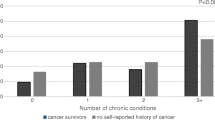Abstract
Acute myeloid leukaemia (AML) is mainly affecting elderly patients. Elderly patients are increasingly affected by impairment of functional status (FS). FS is of prognostic relevance for survival in different tumours. Data for patients with AML are rare. Within a prospective trial we recruited patients with newly diagnosed AML and measured FS by two different methods: Karnofsky performance status (KPS) and instrumental activities of daily living (IADL). Sixty-three patients aged 19–85 years (median 61.1) were included. Twenty-three had prior myelodisplastic syndrome (MDS), 7 favourable, 17 unfavourable karyotype. Fifty received induction chemotherapy, 13 palliative chemotherapy. Median survival was 15.2 months (95% CI, 10.8–22.3) in all patients. Age, cytogenetic risk group, and impaired KPS and IADL significantly influenced median survival in univariate analysis. Impairment of IADL was the single most predictive variable. In multivariate analysis, impairment of IADL Score (HR:4.3, 95% CI 1.7–10.5, P = 0.001) and of KPS (HR:4.8, 95% CI 1.9–12.3, P = 0.001), and unfavourable cytogenetic risk group (HR:6.0, 95% CI 2.5–14.3, P < 0.001) significantly predicted median survival. In patients with AML, FS and not age is a major predictor of survival. The influence of FS is independent from cytogenetic risk group. IADL measurement adds information to KPS. The results have to be confirmed in a large sample of patients.

Similar content being viewed by others
References
Afifi AA (1984) Computer-aided multivariate analysis. Chapman & Hall/ CRC, New York
Altman DG (1991) Practical statistics for medical research. Chapman & Hall, London
Belsley DA, Kuh E, Welsch RE (1984) Regression diagnostics: identifying influential data and sources of collinearity. Wiley, New York
Bennett JM et al (1976) Proposals for the classification of the acute leukaemias. French–American–British (FAB) cooperative group. Br J Haematol33(4):451–458
Byrd JC et al (2002) Pretreatment cytogenetic abnormalities are predictive of induction success, cumulative incidence of relapse, and overall survival in adult patients with de novo acute myeloid leukemia: results from Cancer and Leukemia Group B (CALGB 8461). Blood 100(13):4325–4336
Estey EH (2000) How I treat older patients with AML. Blood 96(5):1670–1673
Extermann M et al (1998) Comorbidity and functional status are independent in older cancer patients. J Clin Oncol 16(4):1582–1587
Ferrara F et al (1998) Acute myeloid leukemia in the elderly: a critical review of therapeutic approaches and appraisal of results of therapy. Leuk Lymphoma 29(3–4):375–382
Grimwade D et al (2001) The predictive value of hierarchical cytogenetic classification in older adults with acute myeloid leukemia (AML): analysis of 1065 patients entered into the United Kingdom Medical Research Council AML11 trial. Blood 98(5):1312–1320
Gupta V et al (2005) Disease biology rather than age is the most important determinant of survival of patients > or = 60 years with acute myeloid leukemia treated with uniform intensive therapy. Cancer 103(10):2082–2090
Hiddemann W et al (1999) Management of acute myeloid leukemia in elderly patients. J Clin Oncol 17(11):3569–3576
Hoyle CF et al (1989) AML associated with previous cytotoxic therapy, MDS or myeloproliferative disorders: results from the MRC’s 9th AML trial. Br J Haematol 72(1):45–53
Karnofsky DA Adelmann WH, Craver FL (1948) The use of nitrogen mustard in the palliative treatment of carcinoma. Cancer 1:634–656
Lawton MP Brody EM (1969) Assessment of older people: self-maintaining and instrumental activities of daily living. Gerontologist 9(3):179–186
Leith CP et al (1997) Acute myeloid leukemia in the elderly: assessment of multidrug resistance (MDR1) and cytogenetics distinguishes biologic subgroups with remarkably distinct responses to standard chemotherapy. A Southwest Oncology Group study. Blood 89(9):3323–3329
Löwenberg B (2001) Managing therapy in older adult patients with acute myeloid leukemia. Semin Hematol 38(3 Suppl 6): 10–16
Matthews JP et al (2001) Patterns of failure with increasing intensification of induction chemotherapy for acute myeloid leukaemia. Br J Haematol 113(3):727–736
Repetto L et al (1998) Performance status and comorbidity in elderly cancer patients compared with young patients with neoplasia and elderly patients without neoplastic conditions [see comments]. Cancer 82(4):760–765
Reuben DB et al (1992). Value of functional status as a predictor of mortality: results of a prospective study [published errata appear in Am J Med 1993 Feb 94(2):232 and 1993 May 94(5):560]. Am J Med 93(6): 663–669
Ries LAG et al (2001) SEER Cancer Statistics Review, 1973–1998, National Cancer Institute. Bethesda, http://www.seer.cancer.gov/Publications/CSR1983–1988/
Sekeres MA et al (2004) Decision-making and quality of life in older adults with acute myeloid leukemia or advanced myelodysplastic syndrome. Leukemia 18(4):809–816
Tallman MS, Gilliland DG, Rowe JM (2005) Drug therapy of acute myeloid leukemia. Blood 106(4):1154–1163
Wedding U, Bokemeyer C, Meran JG (2004) Elderly patients with acute myeloid leukaemia: characteristics in biology, patients and treatment. Recommendations of the Working Group Geriatric Oncology of the German Society for Haematology and Oncology (DGHO), the Austrian Society for Haematology and Oncology (OGHO) and the German Society for Geriatrics (DGG). Onkologie 27(1):72–82
Zagonel V et al (2002) The comprehensive geriatric assessment (CGA) predicts mortality among elderly cancer patients (ECP). Proc Am Soc Clin Oncol 21:1458
Acknowledgments
The authors wish to thank Grit Schröder and Diana Kathe for the helpful work with the data management. We specially thank our colleague Sebastian Scholl for critical review of the manuscript and most helpful comments. This work was supported by a grant of the German Cancer Aid 70-2445-Hö-3.
Author information
Authors and Affiliations
Corresponding author
Rights and permissions
About this article
Cite this article
Wedding, U., Röhrig, B., Klippstein, A. et al. Impairment in functional status and survival in patients with acute myeloid leukaemia. J Cancer Res Clin Oncol 132, 665–671 (2006). https://doi.org/10.1007/s00432-006-0115-7
Received:
Accepted:
Published:
Issue Date:
DOI: https://doi.org/10.1007/s00432-006-0115-7



